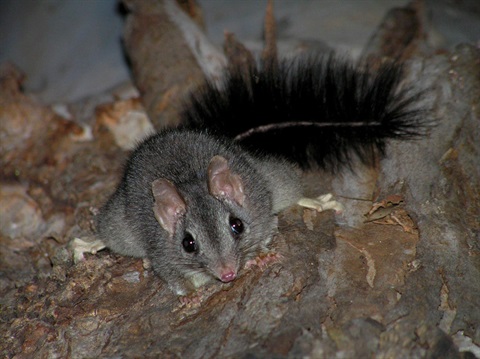Fauna monitoring

We manage many bushland reserves and roadsides throughout the shire. By protecting and restoring these areas, we hope to enhance the habitat for our local fauna.
As part of our Biodiversity Strategy, we have developed a fauna monitoring program to help gather data on fauna activity in our bushland reserves and roadside areas.
The purpose of our fauna monitoring program is to:
- develop a broad picture of what species exist within our council managed land. This information will help gain an understanding of health and biodiversity of reserves/habitats.
- help evaluate the impact and effectiveness of management decisions.
- assist us to identify and prioritise ways to improve habitat for relevant species.
We use a range of monitoring methods including:
- Nest boxes. Our nest box monitoring program is focused on Brush-tailed Phasogale. Nest boxes allow us to monitor tree living or arboreal wildlife via our annual nest box checks. They also provide refuges where there is a lack of hollows for nesting.
- Spotlighting. Conducted with a group, spotlight evenings use high-powered lights to identify and collect information on species active at night. Spotlighting allows us to record the presence of nocturnal fauna such as possums and gliders, which are prey for the threatened Powerful Owl.
- Bird surveys. Our October Bird Blitz and bird surveys throughout the year allow us to monitor the species diversity and number of birds present in council reserves and roadside areas
The data we record during these activities is shared with other databases such as the Victorian Biodiversity Atlas and Birdata.
Build your own nest box
Would you like to know more about nest boxes and how to build them? We have created a nest box information sheet(PDF, 243KB) to answer some questions you may have.
You can also buy one instead of building your own, there are many businesses that you can purchase them from. Search online to find a supplier near you.
Creatures of the night spotlighting results 2023
Whoooo did we spot this year on our Creatures of the Night surveys?
In 2023, we went spotlighting in each of our six biolink areas and recorded 91 individuals of 14 species. Visibility was a little more challenging due to the abundant foliage on all the eucalypts. We are pleased to report than Common Ringtail Possums were found in across all six biolinks. Ringtails are an important prey species for one of our indicator species, the Powerful Owl.
It is quite unlikely to see the threatened Powerful Owl which has a huge home range, but those who attended the Hobbs Road, Bullengarook survey were delighted to see a Southern Boobook Owl. These small owls are reasonably common, but rarely seen. This particular individual was very bold and allowed a group of twenty adults and children excellent views.
Another highlight was a Common Brushtail Possum in the Kyneton area with a young possum on her back! We also saw sleeping birds, and frogs including the Peron’s Tree Frog. A more detailed report of the 2023 results is being prepared and will be posted on our website soon.
A huge thank you to everyone who joined members of the Environment Team on night walks in the reserves and roadsides of the Macedon Ranges. These spotlighting surveys are an essential part of our biodiversity monitoring program, helping us assess the health of our forests and woodlands. And a fun part of the annual Autumn Festival!
We couldn’t do this activity without our citizen scientists – including adults and children, locals and visitors from Melbourne, and even from overseas! We would like to thank everyone who came along – and hope to see you next year.
Nest box monitoring webinars
Glorious Greater Gliders Webinar
Did you know the Greater Glider was added to Australia's list of endangered wildlife in July 2022, having previously been listed as vulnerable?
Greater Gliders have a high dependence on forest and large hollow-bearing trees, habitat loss and fragmentation through clearing and bushfires pose a threat.
In this webinar, Brad Blake from ProCon Pest and Wildlife Management presents on Greater Gliders and what you can do to help protect this important species. Brad also discusses the high-tech nest boxes he uses and how he is tracking the genetics of the species.
Brad and his team work closely with Greening Australia in monitoring nest boxes in Gippsland and has extensively surveyed the Wombat State Forest. Without old-growth forests and the hollows found in those established trees to call home, greater gliders cannot survive.
Subscribe to our Environment eNewsletter to receive updates on the program and other local environment initiatives.